July 21, 2021
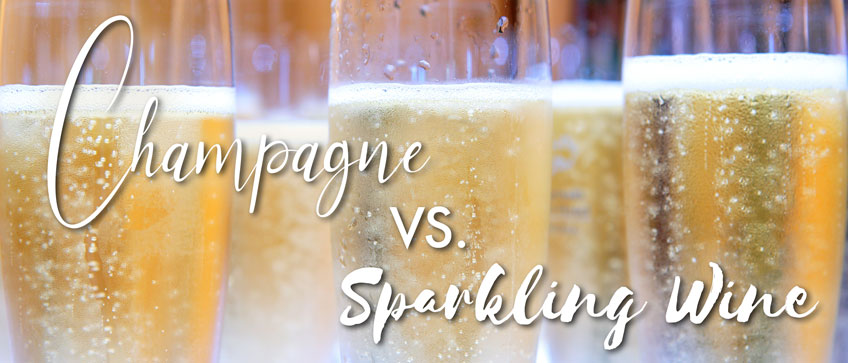
Everyone loves a little bit of bubbly but do you know what you're drinking? Are they the same? Is one better than the other? Celebrations aren't the same without these bubbly beverages but with their similar yet different names, it often causes some confusion. In the end, we're talking about wine and all wines need to be properly stored in order to fully enjoy what they have to offer. This guide to sparkling wines will answer all your questions about this classic celebratory beverage.
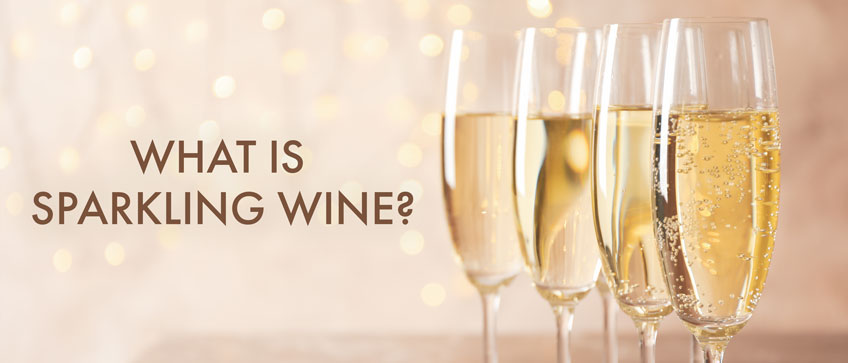
What is Sparkling Wine?
All champagne is sparkling wine but not all sparkling wine is champagne. Let us explain further. Sparkling wine is any carbonated wine, which includes carbonated wines made from a variety of grapes and they can be different colors but they all use carbon dioxide to create their iconic bubbly effect. This generic term, sparkling wine, encompasses the more specific sub-category of champagne.
The fizz and bubbles occur from the natural fermentation process. When sugar is added to the yeast, the yeast will react with the sugar and create carbon dioxide. The carbon dioxide is trapped and bottled for your enjoyment.
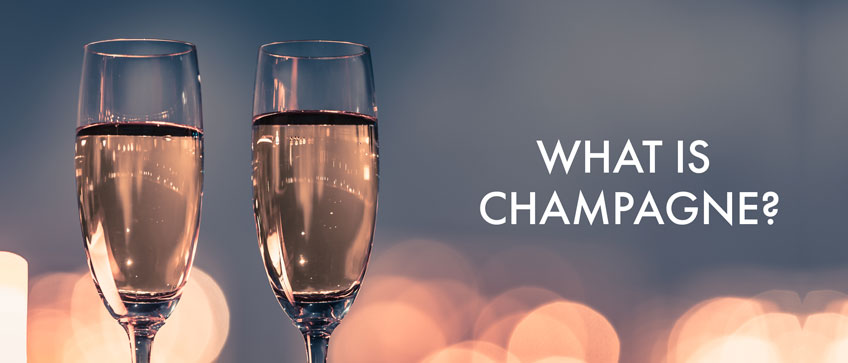
What is Champagne?
While many people use champagne and sparkling wine interchangeably, it's actually incorrect. A sub-category of sparkling wine, champagne gets its name from the Champagne region of France. Only sparkling wines from the Champagne region can be called Champagne. If they are made anywhere else, they are simply referred to as sparkling wines. Champagne accounts for 60% of France's sparkling wine production.
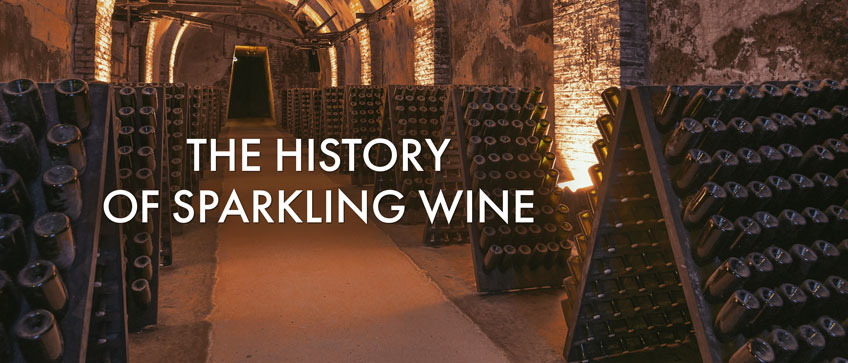
The History of Sparkling Wine
Shockingly the sparkling beverage has been around since 4000 BC, found in ancient Greece and Rome. The science behind the effervescent sensation was not understood back then and people believed spirits were involved in the creation of the bubbles.
The most famous story of the invention of sparkling wine dates back to the 1600's. The story is told that a monk Dom Pérignon from Champagne, France bottled his wine before it was fully fermented due to the low temperatures, which disrupt the fermentation process. When the temperature rose again, the yeast continued its fermentation process and the carbon dioxide had nowhere to escape to, creating the first bottle of champagne.
Due to the high pressure causing bottles to explode, until the 18th century, many winemakers had to wear an iron mask. When the French started shipping sparkling wine to England, the English decided to put it in thicker bottles with corks to prevent these explosions.
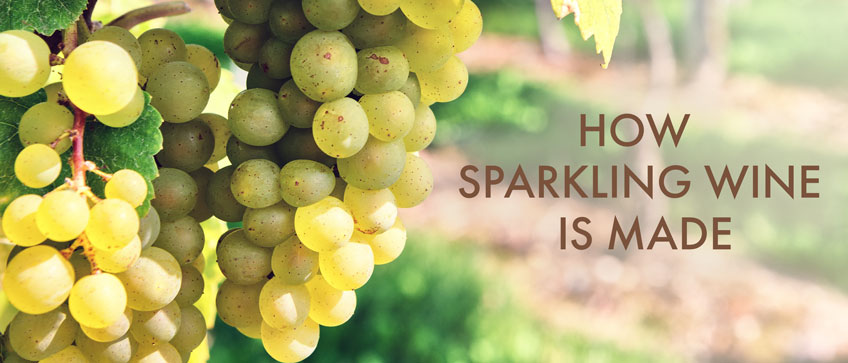
How Sparkling Wine is Made
Modern sparkling wines are not made by accident. The process is one that has been well established and is designed to create consistent tasting wines every time. Every sparkling wine must go through two fermentation processes. It is the second fermentation process that produces the bubbles and differentiates them from one another.
Six types of sparkling wines can be produced from these two production methods - Traditional Method and Tank Method.>
Traditional (Classic) Method - This method requires the second fermentation to take place in the bottle, where sugar and yeasts are added. This method is more complex and requires the winemaker to handle the bottles many times. This method is used to create champagne and it produces smaller bubbles. These smaller bubbles are more persistent through the wine.
Tank (Charmat) Method - In this method, the second fermentation stage occurs in a large steel tank. This produces larger bubbles, which are found in Prosecco. This process is faster, less expensive, and produces a fruitier flavor than the traditional method.
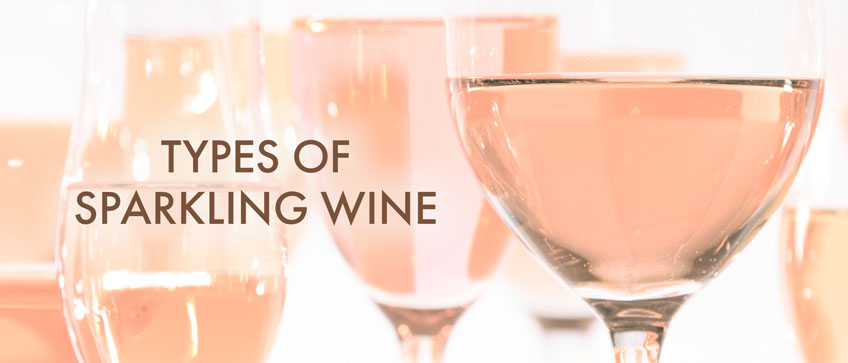
Types of Sparkling Wine
The six most popular types of sparkling wines available are:
Champagne - The most well-known of the sparkling wines, Champagne, is the reason why we have to dedicate an article to the difference between champagne and sparkling wines. Champagne comes from the Champagne region of France and it is a versatile beverage that goes with just about any meal. The small bubbles produce a fruity note but don't necessarily produce a sweet flavor.
Prosecco - Originated from the village of Prosecco, Italy, this sparkling wine is made from Glera grapes. This sparkling wine uses the tank method to produce and tends to have a sweeter taste. The larger bubbles in this wine also allow it to be used in cocktails for a bubbly addition.
Cava - This Spanish sparkling wine comes from the town of Catalonia, Spain. It is produced using the traditional method and is primarily made of Macabeo grapes. These grapes produce a lemon-like flavor. You can also find these wines made with Xarello and Parellada grapes, which produce a fruiter profile with notes of pear and citrus. All cavas are quite floral and are not as sweet.
Crémant - These sparkling wines can be produced in several areas of France, including, Limoux, Loire, and Burgundy. This sparkling wine is produced using the traditional method, like champagne, producing a wine with smaller bubbles. The flavors of these wines vary depending on the types of grapes used; however, many will have a creamy and nutty flavor and aren't as sweet.
Sekt - This sparkling wine derives from Germany and is known for its low sweetness and alcohol content, around 6%. These sparkling wines often have notes of apples, pears, and white flowers. The natural acidity and fruitiness are popular around Germany. This wine is produced using both winemaking methods depending on the type.
Rosé - This sparkling wine is growing in popularity and is known for its pink hue and fruity aroma. You will very frequently find notes of strawberry, citrus, honeydew, rose petal, and rhubarb in these sparkling wines. These wines are produced everywhere but most commonly in Provence, France.
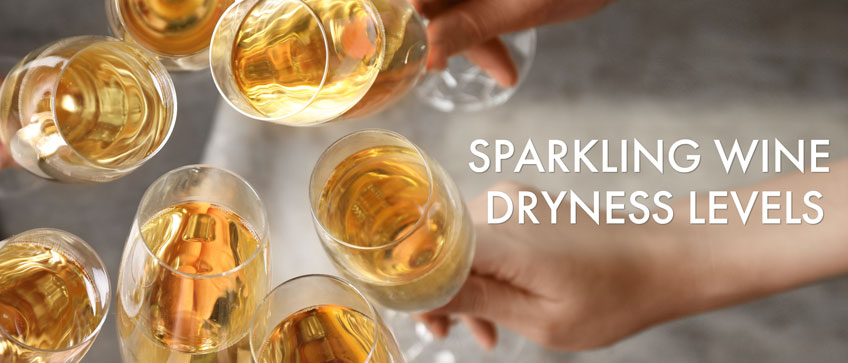
Sparkling Wine Dryness Levels
When shopping for sparkling wines, you will need to consider the dryness of the wine. This is measured by the amount of residual sugar in grams per liter of wine. The dryness levels have very specific terminology and they're not exactly intuitive. Here's a simple explanation for each of these dryness levels.
Extra Brut (0-6 g/l)
This is the very driest sparkling wine available and is produced by the yeast consuming almost all of the sugars in the wine during the fermentation process. Cava is the most popular type of sparkling wine in this category. These dry wines pair best with fried foods and raw seafood, like oysters and sashimi.
Brut (0-12 g/l)
This is the most popular variety of sparkling wine because it is dry but still has a hint of sweetness. Brut is most commonly found in Champagne, which is why it is one of the most popular choices. This dryness level also goes well with a wide range of foods, including, cheese, seafood, and mushrooms. The slight sweetness really enhances the flavors in these foods.
Extra Dry (12-17 g/l)
While it sounds like this would contain less sugar, it actually contains more sugar than the Brut varieties. This variety won't taste sweet but the hint of sweetness will come off much stronger than the Brut versions. Proseccos are most commonly extra dry. These wines pair best with more savory foods, like charcuterie, deviled eggs, and asparagus.
Demi-Sec (32-50 g/l)
Now we venture into the actual sweet category of sparkling wines. These sparkling wines are often enjoyed with dessert. You won't often find champagnes in this category. These wines actually have a noticeable sweetness and pair best with strawberries, chocolate, and cheesecake.
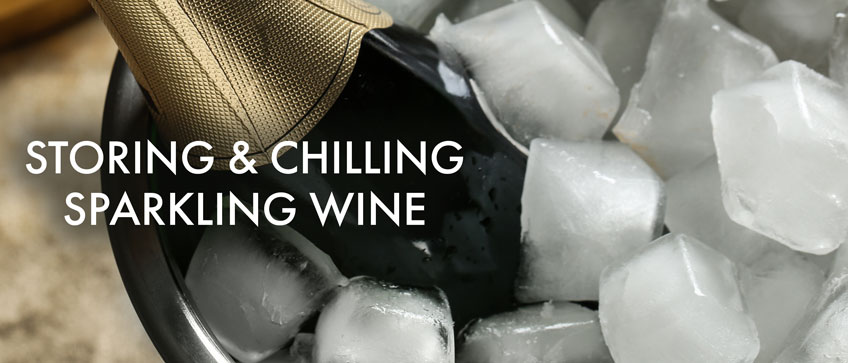
Storing and Chilling Sparkling Wine
Should you aerate red wine?
Sparkling wines can be as delicate as non-sparkling wines, therefore, proper storage is so important if you want to preserve your sparkling wine and if you want to serve them properly. While a bucket of ice is a great way to quickly chill a bottle, you don't get the precise temperature for serving, which can affect the bubbles in your sparkling wine. Too hot or too cold your wine can go flat quickly. We recommend using a wine refrigerator for preserving and storing sparkling wines.
A wine refrigerator stores your wines at a precise and unwavering temperature, preventing your wines from being damaged and protecting the bubbly effervescence. With Tru-Vino technology, your wine will stay at the temperature you set it to with no fluctuations. You can learn more about this innovative temperature control technology, here.
Another benefit of storing your sparkling wines in a wine refrigerator is that your wines will be stored horizontally, preventing the cork from drying out and allowing your wine to be chilled evenly. You ideally want your sparkling wine at 50 to 40 degrees Fahrenheit for the perfect sip. When it comes to sparkling wine storage, we highly recommend the Allavino FlexCount range for its unique cradling shelves. These shelves have a cradling shape that allows you to perfectly store large and unusually shaped bottles, like in the case of sparkling wines.
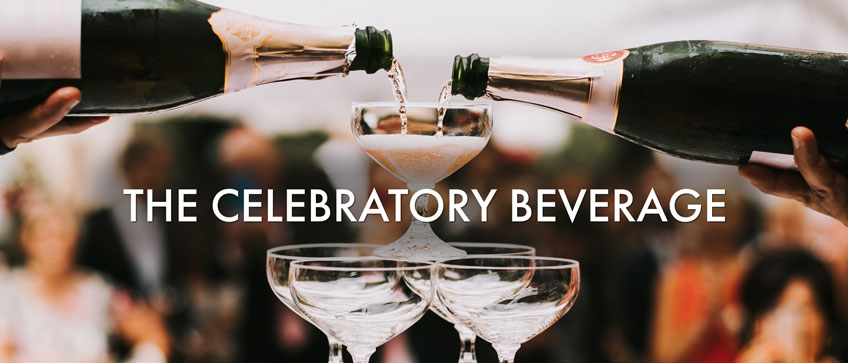
Sparkling Wine - The Celebratory Beverage
What is a celebration without a little bubbly? It has become the quintessential beverage for anything from birthdays to anniversaries to weddings and promotions. Read about choosing champagne for your budget here. You also don't need a reason to enjoy a good bottle of sparkling wine, you just need some knowledge on how to select it and serve it. Whether you like your sparkling wine a little rosy or extra dry, Beverage Factory can help answer all your questions about champagnes, sparkling wines, and so much more. Contact our experts at 800-710-9939.


 Single Faucet Kegerator Beer Dispensers
Single Faucet Kegerator Beer Dispensers Dual Faucet Two Tap Kegerators
Dual Faucet Two Tap Kegerators Triple Faucet Three Tap Kegerators
Triple Faucet Three Tap Kegerators Undercounter Built-In Kegerators
Undercounter Built-In Kegerators Outdoor Kegerator Beer Dispensers
Outdoor Kegerator Beer Dispensers Commercial Kegerators
Commercial Kegerators Mini Kegerators
Mini Kegerators Cold Brew & Nitro Coffee Dispenser Kegerators
Cold Brew & Nitro Coffee Dispenser Kegerators Carbonated Water Kegerators
Carbonated Water Kegerators Home Brew Kegerators
Home Brew Kegerators 15" Kegerators
15" Kegerators Kombucha Equipment
Kombucha Equipment Guinness® Dispensing Kegerators
Guinness® Dispensing Kegerators Vending Kegerators
Vending Kegerators Wine Kegerators
Wine Kegerators Kegerator Cabinets
Kegerator Cabinets Kegerator Covers and Accessories
Kegerator Covers and Accessories Kegerators
Kegerators Kegerator Conversion Kits
Kegerator Conversion Kits Kegs & Keg Accessories
Kegs & Keg Accessories Beer Faucets
Beer Faucets Beer Shanks
Beer Shanks Draft Beer Towers
Draft Beer Towers Keg Taps Couplers
Keg Taps Couplers Regulators & Gas Equipment
Regulators & Gas Equipment Beer & Gas Line Hose
Beer & Gas Line Hose Co2 and Nitrogen Air Tanks
Co2 and Nitrogen Air Tanks Beer Line Cleaning Equipment
Beer Line Cleaning Equipment Drip Trays
Drip Trays System Fittings
System Fittings Jockey Boxes
Jockey Boxes Keg Beer Party Pumps
Keg Beer Party Pumps Glassware & Accessories
Glassware & Accessories Guinness® Dispensing Equipment
Guinness® Dispensing Equipment Remote Glycol Systems
Remote Glycol Systems Wine Cooler Refrigerators
Wine Cooler Refrigerators Wine Cellar Cabinets
Wine Cellar Cabinets Wine Racks
Wine Racks Cooling Units
Cooling Units Wine Dispensing Systems
Wine Dispensing Systems Wine Glasses
Wine Glasses Wine Accessories
Wine Accessories Howard Miller Wine & Spirits Furniture
Howard Miller Wine & Spirits Furniture Wine Making
Wine Making Nitro Hot Draft System
Nitro Hot Draft System Ready to Drink Bag-in-a-Box Coffee Dispensing Equipment
Ready to Drink Bag-in-a-Box Coffee Dispensing Equipment Nitrogen Infusers
Nitrogen Infusers Nitrogen Tanks & Generators
Nitrogen Tanks & Generators Nitrogen Beer Regulators
Nitrogen Beer Regulators Nitro Cold Brew Coffee Kegs
Nitro Cold Brew Coffee Kegs Cold Brewed Coffee Tools
Cold Brewed Coffee Tools Espresso Machines
Espresso Machines Cleaning Equipment
Cleaning Equipment Outdoor Appliances
Outdoor Appliances ADA Appliances
ADA Appliances Panel Ready Appliances
Panel Ready Appliances Commercial Grade Appliances
Commercial Grade Appliances Beverage Centers
Beverage Centers Refrigerators
Refrigerators Drawer Refrigerators
Drawer Refrigerators Ice Makers
Ice Makers Water Dispensers & Accessories
Water Dispensers & Accessories Freezers
Freezers Home Brew Equipment Kits
Home Brew Equipment Kits Fermentation Equipment
Fermentation Equipment Boiling and Mashing Equipment
Boiling and Mashing Equipment Home Brew Beer Kegs
Home Brew Beer Kegs Home Brew Kegerator Conversion Kits
Home Brew Kegerator Conversion Kits Brewing Tools
Brewing Tools Home Brew Ingredients
Home Brew Ingredients Cleaning Chemicals
Cleaning Chemicals Test Equipment
Test Equipment Home Brew Beer Bottles and Bottling Equipment
Home Brew Beer Bottles and Bottling Equipment Brewery Fittings
Brewery Fittings Draft Beer Equipment
Draft Beer Equipment Homebrewing Equipment
Homebrewing Equipment Wine Equipment
Wine Equipment Luxury Appliances and Refrigeration
Luxury Appliances and Refrigeration Coffee Equipment
Coffee Equipment Home Bar & Barware
Home Bar & Barware Kombucha
Kombucha The Beverage Blog
The Beverage Blog Frequently Asked Beer Questions
Frequently Asked Beer Questions Shop by Brand
Shop by Brand Shop by Category
Shop by Category



